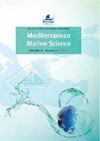西地中海撒丁岛奥里斯塔诺湾的海洋声景观及其时间声学特征
IF 2.3
3区 环境科学与生态学
Q1 MARINE & FRESHWATER BIOLOGY
引用次数: 0
摘要
海洋环境的声景是地声、生物声和人声的结合。在这里,奥里斯塔诺湾的音景进行了调查,奥里斯塔诺湾是撒丁岛西海岸的一个浅海湾,包括一个特殊保护区(栖息地指令)和一个国家海洋保护区。数据收集于2019年7月、2019年11月和2020年5月使用水声设备进行。本研究的目的是表征环境声级(声压级dB为1 μPa),并描述主要的声景成分。声景观表现出明显的昼夜和季节变化:声声级中值在春季最低和最高(120 ~ 140 dB / 1 μPa);新冠肺炎大流行后的封锁)和夏季(128 ~ 150 dB / 1 μPa)。生物声被认为是海豚的“咔哒声”和甲壳类动物的“咔哒声”。虾类活动在夏季占主导地位,而海豚通道在所有采样期间都观察到,占总记录的46.4%。在夏季白天,以船只通道为主,占低频声波空间的42%。地质噪声增加了低频噪声,代表了一个高度可变的局部声景组成部分。海洋声景观是制定海洋生态系统综合管理计划的宝贵工具,可用于评估生境质量、声源特征和评价人为活动的影响。本文章由计算机程序翻译,如有差异,请以英文原文为准。
Marine soundscape and its temporal acoustic characterisation in the Gulf of Oristano, Sardinia (Western Mediterranean Sea)
The soundscape of the marine environment is a combination of geophony, biophony and anthropophony. Here, the soundscape of the Gulf of Oristano, a shallow inlet on the western coast of Sardinia including a special conservation area (Habitat Directive) and a national marine protected area, was investigated. Data collection was performed during July 2019, November 2019 and May 2020 using underwater acoustic equipment. The goal of this study was to characterise the ambient sound levels (Sound Pressure Level dB re 1 μPa) and describe the main soundscape components. The soundscape exhibited significant circadian and seasonal variations: the lowest and highest median SPL values were observed in the Spring (120–140 dB re 1 μPa; post-COVID-19 pandemic lockdown) and the Summer (128–150 dB re 1 μPa) respectively. Biophony was identified and characterised as dolphins’ ‘clicks’ and crustaceans’ ‘snapping’. Shrimp activity was dominant in the summer, while dolphin passages were observed across all sampling periods, accounting for 46.4% of the total recordings. Anthropophony, namely vessel passages, was predominant in the summer during the day-time and represented up to 42% of the acoustic space in the low-frequency band. Geophony increased low-frequency noise, and represented a highly variable component of the local soundscape. The marine soundscape is a valuabletool for defining integrated management plans for marine ecosystems, allowing the assessment of habitat quality, characterisation of sound sources and evaluation of the impact of anthropogenic activities.
求助全文
通过发布文献求助,成功后即可免费获取论文全文。
去求助
来源期刊

Mediterranean Marine Science
MARINE & FRESHWATER BIOLOGY-
CiteScore
5.20
自引率
17.90%
发文量
34
审稿时长
>12 weeks
期刊介绍:
The journal Mediterranean Marine Science (MMS), published by the Hellenic Centre for Marine Research (HCMR), issues three volumes annually. The journal welcomes original research articles, short communications, New Mediterranean Biodiversity records, extended reviews, comments, and Theme sections in all fields of Oceanography, Marine Biology, Marine Conservation, Fisheries and Aquaculture in the Mediterranean area and the adjacent regions. All content is peer reviewed.
 求助内容:
求助内容: 应助结果提醒方式:
应助结果提醒方式:


